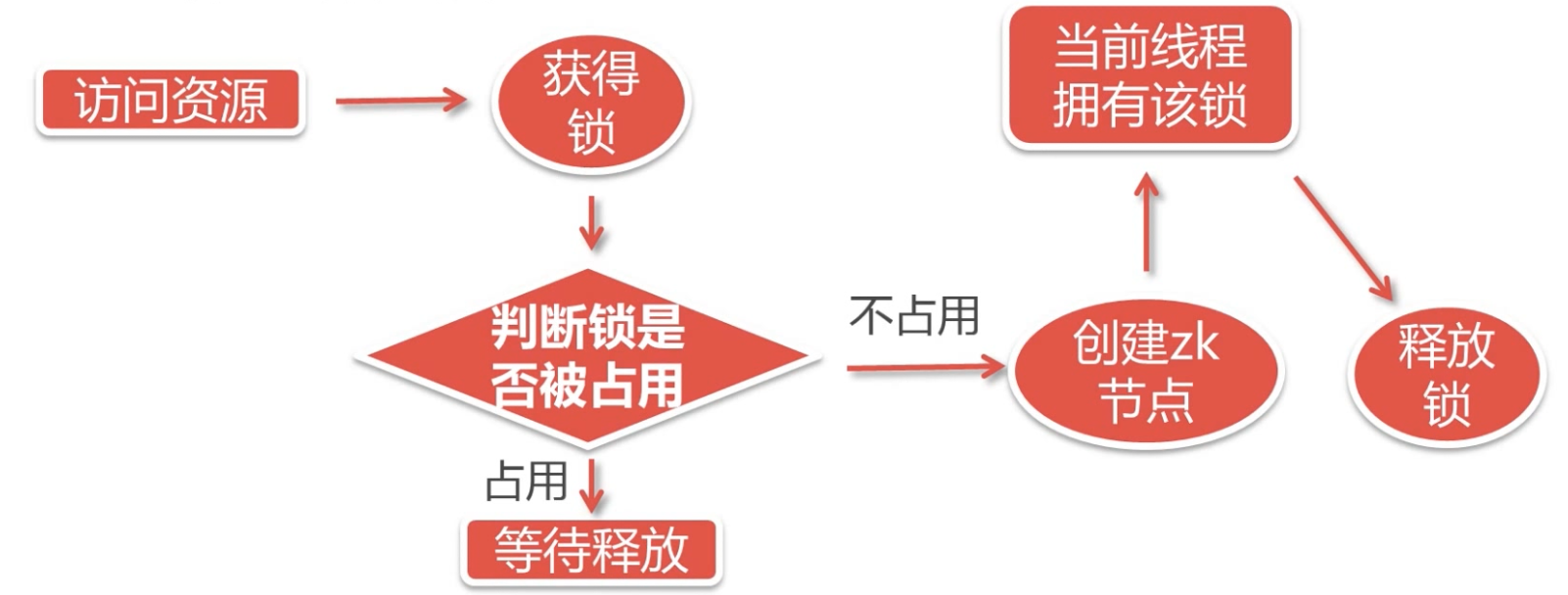代码地址:springboot-dubbo
第9章 分布式锁
9-1 分布式锁的引入
多个系统共享数据,并发下,不加锁,会导致数据不一致

所以引出zookeeper分布式锁
目的:数据最终一致性(数据库)
9-2 curator与springboot整合
之前:用curator工厂类创建客户端,然后.start启动
结合spring:在web应用下,curator随spring容器启动
\configure
1
2
3
4
5
6
7
8
9
10
11
12
13
14
15
16
17
18
19
20
21
22
23
24
25
26
27
28
29
30
31
32
33
34
35
36
37
38
39
40
41
42
43
| @Configuration
public class CrutorConf {
private String zkServerPath = "10.211.55.6:2181";
private int retryN = 10;
private int retryT = 5000;
public RetryPolicy getRetryPolicy(){
RetryPolicy retryPolicy = new RetryNTimes(retryN, retryT);
return retryPolicy;
}
public CuratorFramework getClient(){
CuratorFramework client = CuratorFrameworkFactory.builder()
.connectString(zkServerPath)
.sessionTimeoutMs(10000)
.connectionTimeoutMs(5000)
.retryPolicy(this.getRetryPolicy())
.build();
client.start();
return client;
}
@Bean
public ZKCrutor zKCrutor(){
ZKCrutor zKCrutor = new ZKCrutor(this.getClient());
zKCrutor.init();
return zKCrutor;
}
}
|
\utils
1
2
3
4
5
6
7
8
9
10
11
12
13
14
15
16
17
18
19
20
| public class ZKCrutor {
private CuratorFramework client = null;
private String namespace = "workspace";
public ZKCrutor(CuratorFramework client){
this.client = client;
}
public void init(){
client.usingNamespace(namespace);
}
public boolean isAlive(){
return client.isStarted();
}
}
|
\controller
1
2
3
4
5
| @RequestMapping("/testZKCrutor")
String testZKCrutor(){
boolean isAlive = zkCrutor.isAlive();
return isAlive?"连接":"断开";
}
|
改进:一个session(浏览器)对应一个zKcrutor,而不是整个容器(application)共用一个zkClient。浏览器第一次连接,就创建zKcrutor,然后放进session,之后同一个session访问就返回该zkClient。
9-3 开发分布式锁
分布式锁的流程

开发分布式锁
\utils
1
2
3
4
5
6
7
8
9
10
11
12
13
14
15
16
17
18
19
20
21
22
23
24
25
26
27
28
29
30
31
32
33
34
35
36
37
38
39
40
41
42
43
44
45
46
47
48
49
50
51
52
53
54
55
56
57
58
59
60
61
62
63
64
65
66
67
68
69
70
71
72
73
74
75
76
77
78
79
80
81
82
83
84
85
86
87
88
89
90
91
92
93
94
95
96
97
98
99
100
101
102
103
104
105
106
107
108
109
110
111
112
113
| @Slf4j
public class DistributedLock {
CuratorFramework client = null;
private static CountDownLatch zkLocklatch = new CountDownLatch(1);
private static final String ZK_LOCK_PROJECT = "mxx-locks";
private static final String DISTRIBUTED_LOCK = "distributed_lock";
public DistributedLock(CuratorFramework client){
this.client = client;
}
public void init(){
client = client.usingNamespace("ZKLocks-Namespace");
try {
if(client.checkExists().forPath("/"+ ZK_LOCK_PROJECT) == null){
client.create()
.creatingParentsIfNeeded()
.withMode(CreateMode.PERSISTENT)
.withACL(ZooDefs.Ids.OPEN_ACL_UNSAFE)
.forPath("/"+ ZK_LOCK_PROJECT);
}
addWatcherToLock("/"+ ZK_LOCK_PROJECT);
}catch (Exception e){
log.error("客户端连接zookeeper错误,请重试...");
}
}
public void getLock(){
while (true){
try{
client.create()
.creatingParentsIfNeeded()
.withMode(CreateMode.EPHEMERAL)
.withACL(ZooDefs.Ids.OPEN_ACL_UNSAFE)
.forPath("/"+ ZK_LOCK_PROJECT+"/"+DISTRIBUTED_LOCK);
return;
}catch (Exception e){
try {
if(zkLocklatch.getCount()<=0){
zkLocklatch = new CountDownLatch(1);
}
zkLocklatch.await();
} catch (InterruptedException e1) {
e1.printStackTrace();
}
}
}
}
public boolean releaseLock(){
try {
if(client.checkExists().forPath("/"+ ZK_LOCK_PROJECT+"/"+DISTRIBUTED_LOCK)!=null){
client.delete().forPath("/"+ ZK_LOCK_PROJECT+"/"+DISTRIBUTED_LOCK);
}
}catch (Exception e){
e.printStackTrace();
return false;
}
return true;
}
public void addWatcherToLock(String path) throws Exception{
final PathChildrenCache chche = new PathChildrenCache(client,path,true);
chche.start(PathChildrenCache.StartMode.POST_INITIALIZED_EVENT);
chche.getListenable().addListener(new PathChildrenCacheListener() {
@Override
public void childEvent(CuratorFramework client, PathChildrenCacheEvent event) throws Exception {
if(event.getType().equals(PathChildrenCacheEvent.Type.CHILD_REMOVED)){
String path = event.getData().getPath();
if(path.contains(DISTRIBUTED_LOCK)){
zkLocklatch.countDown();
}
}
}
});
}
}
|
\configure
1
2
3
4
5
6
7
8
|
@Bean
public DistributedLock distributedLock(){
DistributedLock distributedLock = new DistributedLock(this.getClient());
distributedLock.init();
return distributedLock;
}
|
\controller
1
2
3
4
5
6
7
8
9
10
11
12
13
14
15
16
17
18
| @RequestMapping("/buy")
String buy(){
UserPojo.count = UserPojo.count+1;
return "ok";
}
@RequestMapping("/buyWithLock")
String buyWithLock(){
distributedLock.getLock();
UserPojo.count = UserPojo.count+1;
distributedLock.releaseLock();
return "ok";
}
|
情景推理:
1
2
3
4
5
6
7
8
9
10
11
| 1成功创建(锁了)
2、3同时进入失败,挂起
1释放锁(删除节点,触发监听,countdown使得count=0)
2、3同时被重新启动,重新进入死循环,尝试获取锁
2、3有一个成功了,有一个失败了
比如3失败,他进入catch,重置CountDownLatch,然后等着,直到2用完释放
|
测试分布式锁
ab -n 1000 -c 50 http://localhost:8081/user/buy # count无法达到1000
ab -n 1000 -c 50 http://localhost:8081/user/buyWithLock #count每次都为1000
改进:crutor/分布式锁的代码,正常情况下该放在 produce里面,consumer只完成controller的任务。






